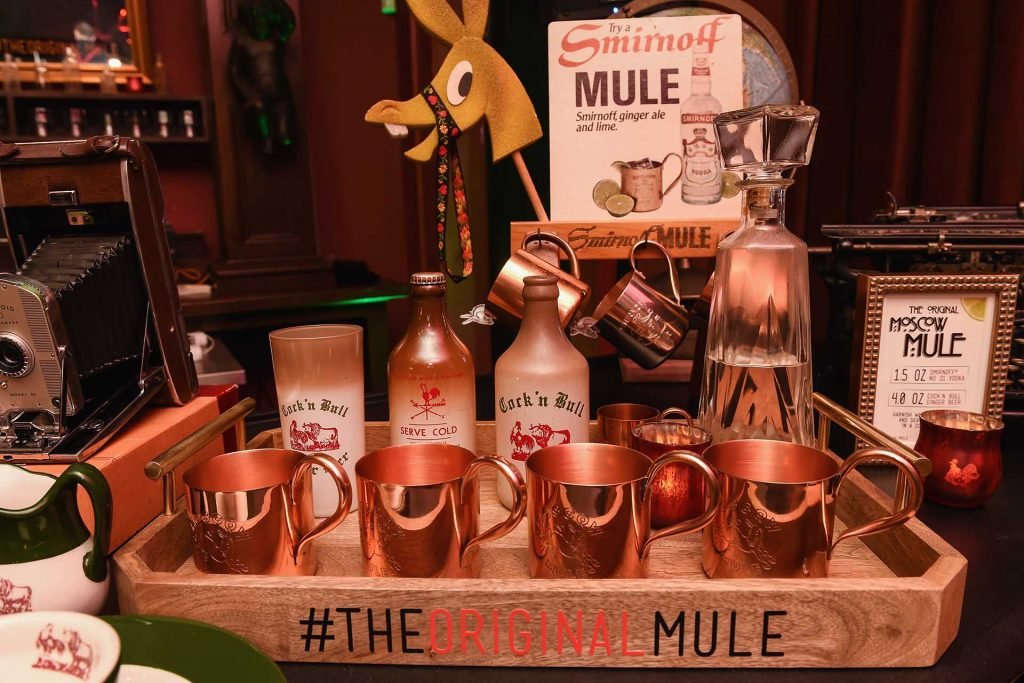The Winding Journey of Vodka from Obscure Liquor to America’s Favorite Spirit

[ad_1]
The story of how vodka became the most-consumed liquor in the United States has everything and nothing to do with Russia. The first vodka sold in the U.S. was distilled in Bethel, Connecticut in 1934, and imported vodka from Russia only reached American markets in the 1970s. America’s favorite vodka cocktails—yes, even the Moscow Mule—were invented in Hollywood bars and New York hotels and were generally unheard of in Russia.
But from its journey to Connecticut and the clever advertising that spurred its meteoric rise, America’s love of vodka began with a socialist revolution and man named Vladimir Smirnov.
The History of Vodka in America
When the 1917 Bolshevik Revolution swept Russia, Smirnov had been producing a million bottles of vodka per day at the Moscow distillery he inherited from his father. The family’s vodka was one of Russia’s top-shelf brands and a favorite among nobles at the Winter Palace, who were enemies of the new regime. After joining the anti-Bolshevik White Army, Smirnov was captured during the uprising, eventually escaping imprisonment and a death sentence before fleeing the country. Penniless, he settled among a community of Russian emigrés in southern France, where he opened a new distillery.

In France, Smirnov struggled to peddle vodka in a market awash with wine and Cognac before he met Rudolph Kunett. A fellow emigré, Kunett had fled to America in 1920. Like Smirnov, Kunett’s family had owned a distillery in the Russian Empire before the revolution, and he dreamed of reviving the family business in his new home. The two brokered a deal giving Kunett U.S. rights to the Smirnov family name—now written as Smirnoff, a French spelling— and distilling process, and Kunett returned to Connecticut to open America’s first vodka distillery in 1934.
Stateside, Prohibition had recently been repealed, and alcohol consumption was on the rise. But Americans were partial to whiskey, and Kunett was selling a meager 6,000 cases of vodka per year. The liquor may have never broken through at all if not for a businessman named John G. Martin, who bought Kunett’s struggling company in 1939 for $14,000, or around $290,000 today.
“I’ll never know why,” Martin told The New York Times decades later. The decision was based on pure instinct but turned out prescient. At the time of the acquisition, Martin was president of Heublein Inc., a producer of foods and bottled cocktails headquartered in Hartford.
Heublein began to market the company’s new investment as “white whiskey,” a drink with no color, smell or taste, which made it a perfect mixer for cocktails or “liquor haters who just want to buy the bang,” as one drinker put it. Soon, intrigued consumers were snapping up vodka to mix with everything from milk to Coca-Cola. A bar on Los Angeles’s Sunset Strip started to mix the liquor with ginger beer and a splash of lime in 1946, creating the wildly popular Moscow Mule. The cocktail had nothing to do with Russia, but its name and innovative use of Polaroid instant photos in promotional efforts endowed the drink with a glamour that Hollywood socialites, and soon the rest of the U.S., couldn’t resist.

Manufacturing Glamour
During the Cold War era, even with anti-Russian sentiment on the rise, vodka would continue to trade on an aura of Russian glamour. “There’s something about the allure of Russia that we know through Russian ballet, Russian literature, the Russian winter—that allure overrides the negativity,” says Darra Goldstein, an author and historian of Russian food and culture. Advertisers stressed vodka’s connections to Imperial Russia rather than Soviet Russia, and ads featured posh garden parties and celebrities smoking cigars or lounging in bathtubs.
The marketing efforts worked. While some Americans called to boycott vodka and the Moscow Mule, many more rushed to the bars in droves to sample the mysterious, taboo cocktail. By 1968, vodka had become the second-most popular spirit in the nation, surpassed only by whiskey.
Until Soviet Union-based Stolichnaya entered the U.S. market in 1972 through an agreement with PepsiCo, the only ties American vodka had to Russia were those of marketing imagination. Stolichnaya capitalized on this early groundwork with advertising campaigns featuring Russian art and architecture. By 1976, vodka was the America’s new number one spirit.

A few years after Stolichnaya entered the market, Absolut debuted across the U.S. with campaigns featuring avant-garde art that caught the attention of a younger generation of bar-goers. While the brand is based in Sweden, Goldstein believes its wildly successful advertising recalled the sense of Russian glamour that had first made vodka a hit in America. “It was the purity, cleanliness and appeal of Scandinavia, but it was also the Russian soul that they were promoting,” she says.
When the Cold War ended and the Soviet Union officially dissolved in 1991, the door was flung open for Eastern European nations to export their vodkas to the United States, and the drink has continued to gain steam ever since. It remains America’s most consumed spirit today, owing to a complex cocktail of emigré connections and a touch of creative advertising.
[ad_2]




